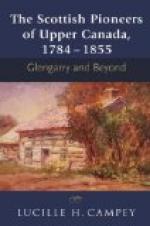Their name for themselves as a people is usually “Innuit” (in Greenland, “Karalit"). Eskimo is a corruption of Eskimantsik, a northern Algonkin word meaning “eaters of raw flesh”. Although their geographical range extends over a distance of about three thousand five hundred miles—from north-easternmost Asia to the east coast of Greenland—the difference in their dialects is little more than that between French and Italian; whereas the difference between the speech of one Amerindian tribe and another—even where they belong to the same language group—is very great—not less than that between German and Latin, or English and French, or even between Russian and Hindustani. This fact—of the widespread Eskimo language—makes some authorities suppose that the presence of the Eskimo in Arctic America cannot be such a very ancient event as, from other evidence, one might believe. Perhaps the bold travelling habits of the Eskimo—which makes them range over vast distances of ice and snow when hunting seals, walruses, whales, musk ox, or reindeer—enables them to keep in touch with their far-away relations.
The canoes or kayaks in which they travel (first described by the Norsemen in the tenth century) are made out of the hide of the seal or walrus. The leather is stretched over a framework constructed from driftwood or whales’ bones. There is a hole in the middle for the man or woman to insert their legs. This hole they fill up with their bodies. If the canoe capsizes, the Eskimo cannot fall out, but bobs up immediately. He and the canoe are really “one-and-indivisible” when he is navigating the seas and lakes, plying deftly a large paddle.
In regard to food they were certainly not particular or squeamish. They loved best of all whales’ blubber, or to drink the fishy-tasting oil from bodies of whales, seals, or walruses. Besides the meat of Polar bears and of any fur animals they could catch, or the musky beef of the musk ox, they devoured eagerly sea birds’ eggs, Iceland moss, and even the parasitic insects of their own heads and bodies! Hearne relates that they will eat with a relish whole handfuls of maggots that have been produced in meat by the eggs of the bluebottle fly! On the other hand, they held cannibalism in horror, whereas for two-two’s their Amerindian neighbours on the west and south would eat human flesh without repugnance.
The Eskimo, though occasionally tall, are as a rule stumpy and thickset, with very small hands and feet, broad faces, and projecting cheekbones, a narrow nose without the aquiline bridge of the Amerindian, slanting narrow eyes, and long heads containing large well-developed brains. In disposition the Eskimo are nearly always merry, affectionate to one another, honest, and modest. Modern travellers in the Arctic regions give them invariably a high character; but Frobisher, Davis, and the explorers of the sixteenth and seventeenth centuries accused them of treachery and an inclination to steal. Iron in any shape or form they could hardly resist taking. Moreover, if they are the same people as the Skraellings of the Norse traditions they must have been of a fiercer disposition a thousand years ago.




